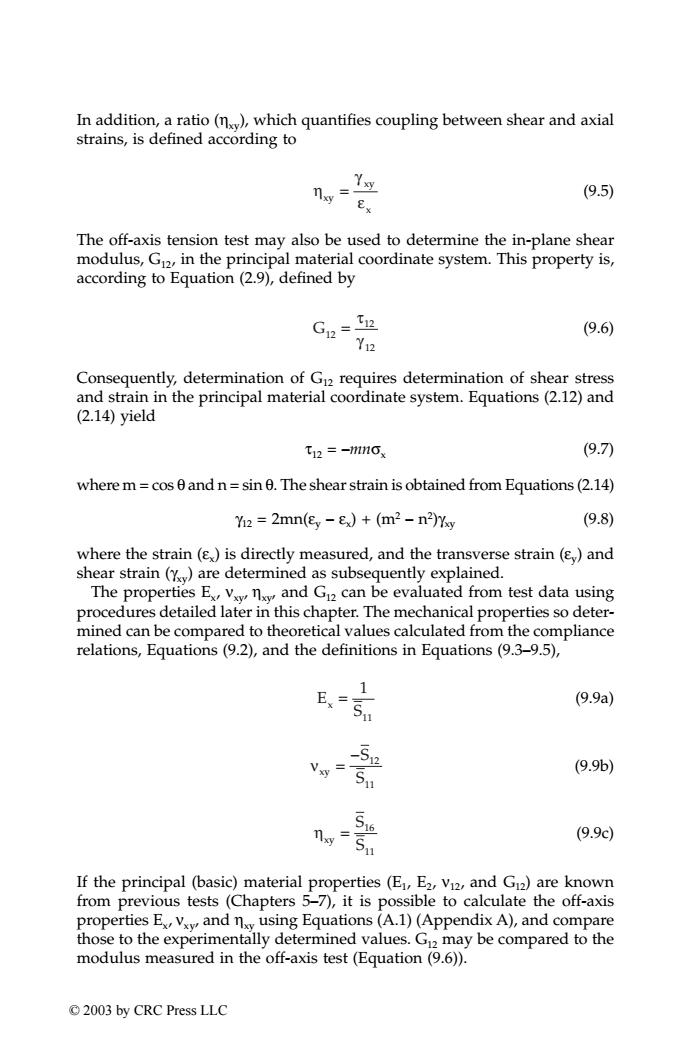正在加载图片...

In addition,a ratio (n),which quantifies coupling between shear and axial strains,is defined according to (9.5) Ex The off-axis tension test may also be used to determine the in-plane shear modulus,G2,in the principal material coordinate system.This property is, according to Equation(2.9),defined by (9.6) Y12 Consequently,determination of G2 requires determination of shear stress and strain in the principal material coordinate system.Equations(2.12)and (2.14)yield T12=-7110x (9.7) where m=cos 0 and n=sin 0.The shear strain is obtained from Equations(2.14) Y2 2mn(y -E)+(m2-n2)Yy (9.8) where the strain(e)is directly measured,and the transverse strain ()and shear strain()are determined as subsequently explained. The properties EVyny and Gi2 can be evaluated from test data using procedures detailed later in this chapter.The mechanical properties so deter- mined can be compared to theoretical values calculated from the compliance relations,Equations (9.2),and the definitions in Equations (9.3-9.5), 1 (9.9a) Vxy=- 52 (9.9b) (9.9c) If the principal (basic)material properties(E,E2,Vi2,and G12)are known from previous tests (Chapters 5-7),it is possible to calculate the off-axis properties E,Vsy and nxy using Equations(A.1)(Appendix A),and compare those to the experimentally determined values.G12 may be compared to the modulus measured in the off-axis test(Equation (9.6)). ©2003 by CRC Press LLCIn addition, a ratio (ηxy), which quantifies coupling between shear and axial strains, is defined according to (9.5) The off-axis tension test may also be used to determine the in-plane shear modulus, G12, in the principal material coordinate system. This property is, according to Equation (2.9), defined by (9.6) Consequently, determination of G12 requires determination of shear stress and strain in the principal material coordinate system. Equations (2.12) and (2.14) yield τ12 = –mnσx (9.7) where m = cos θ and n = sin θ. The shear strain is obtained from Equations (2.14) γ12 = 2mn(εy – εx) + (m2 – n2)γxy (9.8) where the strain (εx) is directly measured, and the transverse strain (εy) and shear strain (γxy) are determined as subsequently explained. The properties Ex, νxy, ηxy, and G12 can be evaluated from test data using procedures detailed later in this chapter. The mechanical properties so determined can be compared to theoretical values calculated from the compliance relations, Equations (9.2), and the definitions in Equations (9.3–9.5), (9.9a) (9.9b) (9.9c) If the principal (basic) material properties (E1, E2, ν12, and G12) are known from previous tests (Chapters 5–7), it is possible to calculate the off-axis properties Ex, νxy, and ηxy using Equations (A.1) (Appendix A), and compare those to the experimentally determined values. G12 may be compared to the modulus measured in the off-axis test (Equation (9.6)). η γ ε xy xy x = G12 12 12 = τ γ E S x = 1 11 νxy S S = − 12 11 ηxy S S = 16 11 TX001_ch09_Frame Page 133 Saturday, September 21, 2002 5:01 AM © 2003 by CRC Press LLC